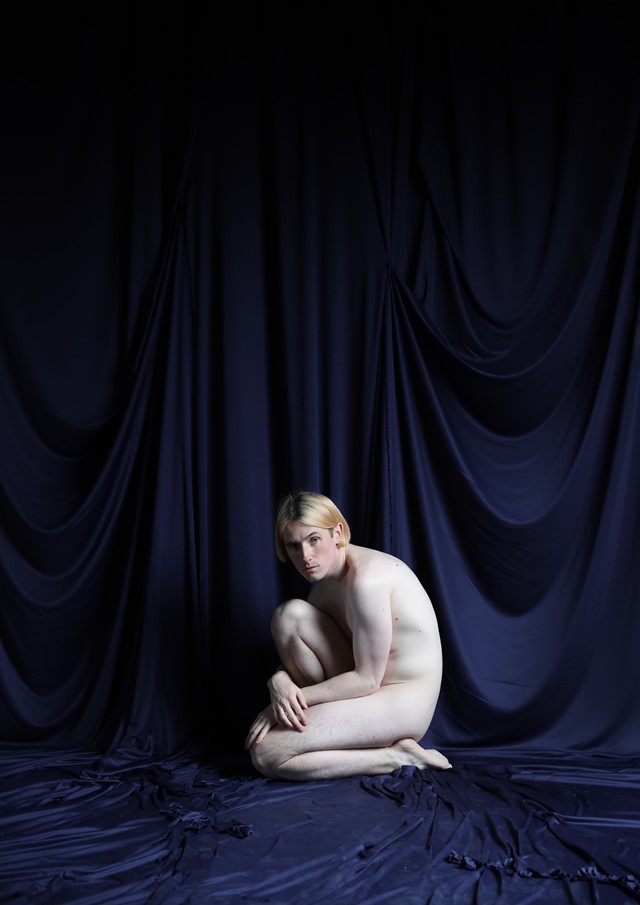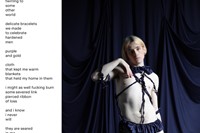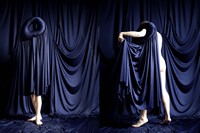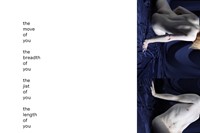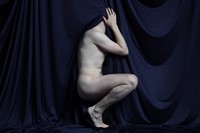The Irish designer talks us through his intensely personal new project, àit don ghrà – a series of nude self-portraits exploring queer sexuality, love and desire
To Richard Malone, Pride is about “loving, radically.” Not just others, but yourself. The Irish designer is known for championing queer and marginalised identities with his work, celebrating “otherness” and the revolutionary power of self-acceptance. “It’s really important for us to prove that queer people get to be individuals,” he explains, passionately. “We do not owe people stereotypes or filters. It is a radical act of love to be completely yourself, through honesty and vulnerability.”
Malone’s most recent project is a proud display of that vulnerability, and perhaps his most intensely personal work to date. In a new Pride-inspired group exhibition, opening this week, the designer is baring his body and soul on camera, posing nude for a series of simple, unretouched self-portraits. The artful images – titled àit don ghrà – show Malone posing in a variety of contortions in front of a majestically lit, draped background. Using his body and some accompanying poetry, he explores the physical stereotypes that surround masculinity and effeminacy, and probes society’s limiting expectations of the human form.
The portraits are part of Out in the World: a new exhibition, running at Dublin’s Irish Emigration Museum, that highlights the untold history of Ireland’s LGBTQ+ diaspora. Curated by historian and activist Dr Maurice J Casey, the show celebrates the queer Irish voices who have helped spark global change – either through protest, constitutional challenge or creative trailblazing. Days before its official opening, Malone told us more about his contribution to the exhibition, his Irish heritage, and why he will always throw love at the “queer part” of his identity.
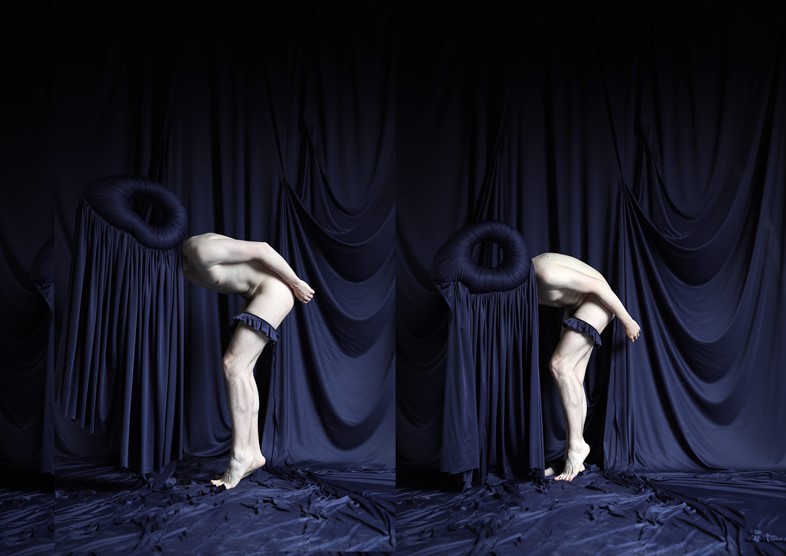
“My work in Out in the World is a series of self-portraits and spoken word poems titled àit don ghrà (‘a place for love’ in English). It’s a very true representation of who I am and what Pride is all about ... To me, Pride means loving, radically. Within that is allowing oneself to be really loved too, which is often the tricky part.
“The queer part of my identity is extremely important to me. Countless times the narrative I speak about in relation to queerness is edited out of my interviews or completely overlooked. The press is much more interested in fetishising my ‘working-class’ or ‘rural-Irish’ roots, like every artist or designer has a box they mustn’t stray out of. This is almost certainly because our majority heteronormative/cisgender-led publications have very limited ways of seeing queer artists and designers. This includes expecting our work to replicate club-kid culture, or to look like some 70s New York dockland fantasy. There is actually really very little room for changes within this perspective, and so many young queer people can feel isolated by these narrow lenses. It can be really challenging to watch a straight-dominated world define what queer art and design should look like, and then inevitably try to sell it back to paying customers. It’s really important for us to prove that queer people get to be individuals and exceptional, and consistently so. We do not owe people stereotypes or filters. It is a radical act of love to be completely yourself, through honesty and vulnerability.
“Within this show, there are so many incredible individuals whose acts of defiance have quite literally built this world that we now get to exist in. Having the historical element of the show really places queerness at the centre of Irish culture and within all of the radical changes that are happening in modern Ireland.
“For someone who designs clothes, I’m actually much happier out of them” – Richard Malone
“The country has a really interesting and constant relationship with emigration and movement, with Irish communities found all around the world. It’s a really tiny place with a huge global influence. In my lifetime, it’s gone from a largely Catholic country to a country that is really representing modernism and equality on so many levels. From voting for equal marriage rights to repealing the Eighth Amendment, it is a signal of significant change to the rest of the world. As a country, the Republic of Ireland is just over 100 years old, which feels mad. In that sense, as a place, whether spiritually or physically, there seems to be some license to reinvent and re-assess what Ireland and Irishness look like. My contribution to this show is in equal parts an acceptance and an assertion of my role within this incredible community, and it is also a very honest exploration of sexuality, desire and love.
“When shooting àit don ghrà, I knew the kind of mood I’d hoped to portray. I wanted to focus on the body, and the defined spaces and expectations of the human form. I was deliberate in curating certain gestures that are effeminate or masculine, like slights of hand, curves of the back and tilts of the head. Certain poses suggest a sort of classical desire or sexuality, while others can accommodate ideas around isolation or sadness or boredom, and all were really explored. Within my work, whether it’s in art galleries or in presenting fashion, there is a real celebration of movement and performance. It’s been vital for as long as I can remember, and I’m always super involved in directing the choreography or using the body to curate a certain type of language or feeling. I guess this is no different, except that it’s me instead of another performer.

“Creating a series of portraits like this involves a certain amount of fabrication and theatre, which is represented in this very classical lighting and draped background. It’s extremely simple really, and everything is stripped right back. The fabrication of the backdrop is shared in these ‘garments’ which extend from tights and frilled jersey to silk organza, or abstract padded shapes. It’s very similar to how I develop the shapes for my clothing or for the huge draped sculptures: they all start on my body and change through a series of trying on and editing.
“The concertina wooden panels give the installation a slightly domestic feel, it feels more informal. I’m always a real fan of mixing these materials. I grew up between very defined or gendered spaces – so learning embroidery, quilting and bread-making from my mother and grandmother in their kitchens, to learning about mixing colours or cement or materials on numerous building sites when I worked with my dad and brother back in Wexford. It’s always fascinated me the types of performance that exist in these spaces, and really made me believe the whole construct is bullshit and is actually a huge effort to uphold.
“In terms of references, there are countless queer image-makers who I adore and whose work was in my mind when trying to create the installation – this includes Eugéne Durieu, Calavas, Eadweard Muybridge, Arthur Schulz, Herbert List, Pajama, George Platt Lynes, also David Hockney and Richard Kern. I’m always attracted to intimate imagery, in capturing some sort of emotion or intention. I never use photoshop – it seems insane to me. Perhaps it’s a tonic to all the false faces and filters we’re bombarded with on social media, which have always frightened me. It’s exciting to see real people. For someone who designs clothes, I’m actually much happier out of them.”
Out in the World is running at The Irish Emigration Museum in Dublin from June 8 to December 1, 2021. The exhibition will also tour to select locations across the world in 2022
